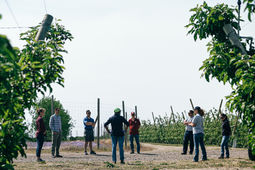Columbia Reach Chiawana Smart Orchard
Washington State's Tree Fruit Research Commission asked innov8.ag to lead a smart orchard project in collaboration with researchers from WSU & OSU at Chiawana Orchards. Our goal is to "sensorize" a orchard from multiple hardware providers, bringing together growers, data, and researchers to create a sustainable, "smart" orchard with insights that impact growers' bottom lines.
Sensor Providers:
Micro-Climate
In collaboration with the WSU AgWeatherNet Team we found not only the orchard-specific climate, but the difference between in-canopy and outside canopy of about 4 degree differences which has implications for growing degree days (GDD).
Soil-Moisture
We confirmed the effectiveness of multiple soil moisture probes from Meter Group, Sentek, and AquaSpy with strong correlation between measurements.
Irrigation Planning Optimization
We consolidated the variables used by the area manager to plan weekly irrigation sets into a irrigation planning dashboard. Subsequently he has all of his data in one place in order to further optimize his planning and make efficient decisions.
Soil-Variation
We identified previously unidentified areas of stress in parts of the orchard block due to soil variation. With implications on how the grower can supplement nutrients and watering to obtain more uniform results.
Imagery
In collaboration with WSU’s Dr. Lav Khot & PhD candidate Abhilash Chandel, we utilized drone imagery to determine evapotranspiration requirements throughout an orchard block with implications to define irrigation zones that again should enable more uniform crop distribution and fruit quality. This validated the importance and capability of apple counting through imaging technology with implications for growers on planning pruning, thinning, harvest, chemical applications, and labor. Subsequently, in 2021 the Smart Orchard Project will expand to incorporate GreenAtlas ATV-Based imaging as a foundational data source.
Connectivity
We utilized multiple forms of connectivity from LoRa to traditional mobile connectivity to private 900MHz connectivity to optimize use cases that best align with each of these technologies.
Hackathons
Through WSU and Microsoft hackathons we determined and defined management zones based on nutrient distribution while enabling WSU’s Bernadita Sallato to establish a relationship between fruit quality and soil nutrient availability.
































